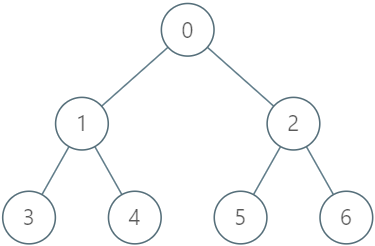给你一棵 n 个节点的树,编号从 0 到 n - 1 ,以父节点数组 parent 的形式给出,其中 parent[i] 是第 i 个节点的父节点。树的根节点为 0 号节点,所以 parent[0] = -1 ,因为它没有父节点。你想要设计一个数据结构实现树里面对节点的加锁,解锁和升级操作。
数据结构需要支持如下函数:
- **Lock:**指定用户给指定节点 上锁 ,上锁后其他用户将无法给同一节点上锁。只有当节点处于未上锁的状态下,才能进行上锁操作。
- **Unlock:**指定用户给指定节点 解锁 ,只有当指定节点当前正被指定用户锁住时,才能执行该解锁操作。
- **Upgrade:**指定用户给指定节点 上锁 ,并且将该节点的所有子孙节点 解锁 。只有如下 3 个条件 全部 满足时才能执行升级操作:
- 指定节点当前状态为未上锁。
- 指定节点至少有一个上锁状态的子孙节点(可以是 任意 用户上锁的)。
- 指定节点没有任何上锁的祖先节点。
请你实现 LockingTree 类:
LockingTree(int[] parent)用父节点数组初始化数据结构。lock(int num, int user)如果 id 为user的用户可以给节点num上锁,那么返回true,否则返回false。如果可以执行此操作,节点num会被 id 为user的用户 上锁 。unlock(int num, int user)如果 id 为user的用户可以给节点num解锁,那么返回true,否则返回false。如果可以执行此操作,节点num变为 未上锁 状态。upgrade(int num, int user)如果 id 为user的用户可以给节点num升级,那么返回true,否则返回false。如果可以执行此操作,节点num会被 升级 。
输入:
["LockingTree", "lock", "unlock", "unlock", "lock", "upgrade", "lock"]
[[[-1, 0, 0, 1, 1, 2, 2]], [2, 2], [2, 3], [2, 2], [4, 5], [0, 1], [0, 1]]
输出:
[null, true, false, true, true, true, false]
解释:
LockingTree lockingTree = new LockingTree([-1, 0, 0, 1, 1, 2, 2]);
lockingTree.lock(2, 2); // 返回 true ,因为节点 2 未上锁。
// 节点 2 被用户 2 上锁。
lockingTree.unlock(2, 3); // 返回 false ,因为用户 3 无法解锁被用户 2 上锁的节点。
lockingTree.unlock(2, 2); // 返回 true ,因为节点 2 之前被用户 2 上锁。
// 节点 2 现在变为未上锁状态。
lockingTree.lock(4, 5); // 返回 true ,因为节点 4 未上锁。
// 节点 4 被用户 5 上锁。
lockingTree.upgrade(0, 1); // 返回 true ,因为节点 0 未上锁且至少有一个被上锁的子孙节点(节点 4)。
// 节点 0 被用户 1 上锁,节点 4 变为未上锁。
lockingTree.lock(0, 1); // 返回 false ,因为节点 0 已经被上锁了。
n == parent.length2 <= n <= 2000- 对于
i != 0,满足0 <= parent[i] <= n - 1 parent[0] == -10 <= num <= n - 11 <= user <= 104parent表示一棵合法的树。lock,unlock和upgrade的调用 总共 不超过2000次。
struct LockingTree {
parent: Vec<i32>,
children: Vec<Vec<i32>>,
locked: Vec<i32>,
}
/**
* `&self` means the method takes an immutable reference.
* If you need a mutable reference, change it to `&mut self` instead.
*/
impl LockingTree {
fn new(parent: Vec<i32>) -> Self {
let n = parent.len();
let mut children = vec![vec![]; n];
for i in 1..n {
children[parent[i] as usize].push(i as i32);
}
Self {
parent: parent,
children: children,
locked: vec![-1; n],
}
}
fn lock(&mut self, num: i32, user: i32) -> bool {
if self.locked[num as usize] == -1 {
self.locked[num as usize] = user;
true
} else {
false
}
}
fn unlock(&mut self, num: i32, user: i32) -> bool {
if self.locked[num as usize] == user {
self.locked[num as usize] = -1;
true
} else {
false
}
}
fn upgrade(&mut self, num: i32, user: i32) -> bool {
let mut curr = num;
let mut nodes = self.children[num as usize].clone();
let mut locked_descendants = vec![];
while curr != -1 {
if self.locked[curr as usize] != -1 {
return false;
}
curr = self.parent[curr as usize];
}
while let Some(node) = nodes.pop() {
nodes.append(&mut self.children[node as usize].clone());
if self.locked[node as usize] != -1 {
locked_descendants.push(node as usize);
}
}
if !locked_descendants.is_empty() {
self.lock(num, user);
for node in locked_descendants {
self.locked[node] = -1;
}
true
} else {
false
}
}
}
/**
* Your LockingTree object will be instantiated and called as such:
* let obj = LockingTree::new(parent);
* let ret_1: bool = obj.lock(num, user);
* let ret_2: bool = obj.unlock(num, user);
* let ret_3: bool = obj.upgrade(num, user);
*/